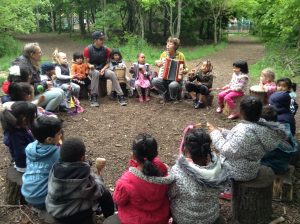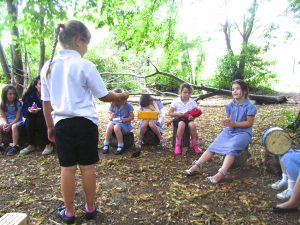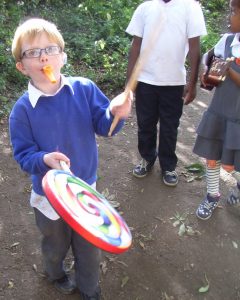A ‘sandwich’ structure is often useful – focussing together > exploring > reinforcing
| —————————————————————————————-
Structured intro at a ‘basecamp: a hello song and other song/s Introducing instruments and ideas; focussed instrument work —————————————————————————————- |
| Extended exploration – moving around the whole area
Child-centred time Adults observe and support ———————————————————————————— |
| Structured plenary back at basecamp: recap ideas and songs; children perform what they’ve been doing
—————————————————————————————- |
At base camp – structured activities:

- somewhere everyone can sit in a circle to focus
- go over any ground rules
- sing familiar and/or new songs – perhaps a song that can be varied, with a few examples from the group of new words about our experiences.
- introduce new instruments, use rhythms together to accompany songs.
- Use drums, drum sticks, claves – tapping the pulse and teaching basic rhythms – use word rhythms (‘croc-o-dile’)
- egg shakers and other shakers
- bells and glockenspiels
- kazoos

- Using two or three different instruments in groups for different sections of a song, such as Toumba on our Let’s Go! CD.
- children responding with their own actions to drum & tambourine signals.
- Storytelling / conducting with instruments representing animals – everyone has an instrument and one person stands in the middle and signals who should play
- Giving input for children to develop/vary in exploration time

Exploration time – roaming around

- Use brightly coloured or large or cheap instruments which won’t get lost easily – drums, tambourines, drum sticks, ukuleles, melodicas, bugles, large shakers, kazoos. Carry them in big bags
- in an outdoors area within a setting: you have more choice of instruments, heavy ones can be carried (lots of drums, or autoharps), and smaller ones can be kept an eye on (deskbells, chime bars, woodblocks)
- keep some instruments for use only at base camp
See more about this on our ‘time to explore’ page
Basecamp conclusion
- talk about and listen to examples of what the children have been engaged in. Younger children are usually not able to recreate what they have played, children from year 1 up may be able to do this
